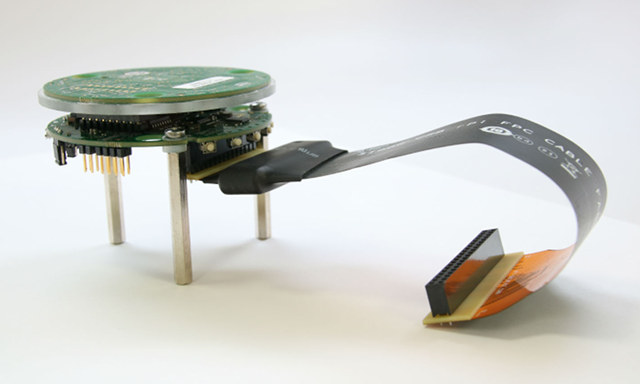We’ve known Intel has been working on Quark S1000 “Sue Creek” processor for voice recognition for several months. S1000 SoC is based on two Tensilica LX6 with HiFi3 DSP, some speech recognition accelerators, and up to 8x microphones interfaces which allows it to perform speech recognition locally. The solution can also be hooked to an application processor via SPI, I2S and USB (optional) when cloud based voice recognition is needed.
Intel has recently introduced their Speech Enabling Developer Kit working with Amazon Alexa Voice Service (AVS) featuring a “dual DSP with inference engine” – which must be Quark S1000 – and an 8-mic array. The kit also includes a 40-pin cable to connect to the Raspberry Pi 3 board.

Intel only provided basic specifications for the kit:
- Intel’s dual DSP with inference engine
- Intel 8-mic circular array
- High-performance algorithms for acoustic echo cancellation, noise reduction, beamforming and custom wake word engine tuned to “Alexa”
- 6x Washers
- 3x 6mm screws
- 3x 40mm female-female standoffs (x3)
- Raspberry Pi connector cable
I could not find detailed information to get started, except for assembly guide shown in the video below. We do not that the kit will work with Amazon Alexa, and requires a few extra bits, namely a Raspberry Pi 3 board, an Ethernet cable, a HDMI cable and monitor, USB keyboard and mouse, an external speaker, a micro USB power supply (at least 5V/1A), and a micro SD card.
The video also points to Intel’s Smart Home page for more details about software, but again I could not find instructions or guide there, except links to register to a developer workshop at Amazon Re:Invent in Las Vegas on November 30, 2017.
Intel Speech Enabling Developer Kit can be pre-ordered for $399 directly on Intel website with shipping planned for the end of November. The product is also listed on Amazon Developer page, but again with little specific information about the hardware and how to use it. One can assume the workflow should be similar to other AVS devkits.
Thanks to Mustafa for the tip.

Jean-Luc started CNX Software in 2010 as a part-time endeavor, before quitting his job as a software engineering manager, and starting to write daily news, and reviews full time later in 2011.
Support CNX Software! Donate via cryptocurrencies, become a Patron on Patreon, or purchase goods on Amazon or Aliexpress





399$ for Alexa? So not worth it
@Paul Taraneh
For some reasons, all Amazon Alexa “far-field” (with more than 2 mics) development kits are expensive:
$499 XMOS VocalFusion 4-Mic Dev Kit for Amazon AVS
$349 Synaptics AudioSmart 4-Mic Development Kit for Amazon AVS
https://developer.amazon.com/alexa-voice-service/dev-kits
These are expensive because you are paying for a low volume (quantity, not audio) development platform which should come with things like software, documentation, example applications, support/community, etc. – all of which cost money to develop and support. Unfortunately IMO, companies like Intel and XMOS (I have no experience with Synaptics) don’t come through when it comes to stuff like documentation, software, etc. The experience may be better for a large company who can demand better support. But for smaller users/evaluators, often what’s really needed to succeed isn’t there out-of-the-box. There IS hope though! Adding basic compatibility with something like… Read more »
Maybe this is a good alternative: https://www.seeedstudio.com/ReSpeaker-Mic-Array-Far-field-w%2F-7-PDM-Microphones–p-2719.html